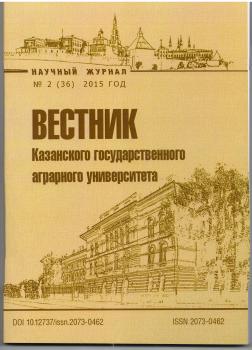Russian Federation
Kazan', Kazan, Russian Federation
CSCSTI 68.75
One of the little-used reserves to improve the efficiency of agriculture, through technical modernization, is the development of melioration. The most effective method of mechanized irrigation is sprinkling, which contributes to the greatest moisture penetration to plants. This method allows you to moisten the leaf surface, soil and ground layers of air, which saves in the dry period. Reducing the park of sprinkling equipment for a number of years led to a reduction in the area of irrigated land, and the operating machines were practically not used due to moral and physical deterioration, the lack of spare parts for repairs and high energy costs. The indicator of the use of sprinklers in the context of the region, in particular, by the agricultural producers of the Republic of Tatarstan in 2014, was 93 percent. At the same time, 13 districts of the region do not have irrigation machines. An application of sprinklers for the cultivation of crops in agriculture is economically justified and promising. The modernization of irrigation equipment should consist in replacing imported, expensive spare parts and parts with cheaper and produced in Russia, wide introduction of an open irrigation system with high efficiency, low energy consumption. To implement these measures, state support measures are necessary. At the same time, the approved mechanism of state subsidizing of machinery manufacturing plants is adopted with a lack of subsidies, which will lead to further development of the situation associated with the technical impoverishment of the agricultural sector. This assumption is proved by the forecast of the level of watering equipment in the Russian Federation until 2020, which takes into account the current trends in the development of a sprinkler park and watering machines and plants.
melioration, irrigation equipment, new technology, subsidies, production costs, irrigated lands, irrigation system, sprinklers, modernization, state support.
Одним из малоиспользуемых резервов повышения эффективности сельского хозяйства посредством технической модернизации является развитие мелиорации [1].
Широкое развитие мелиорации в России приходилось на 1966-1990 гг., годы, что привело к упадку данного направления развития сельскохозяйственного машиностроения в связи с отказом от мероприятий по орошению земель[2]. Торможение развития системы мелиорации в сельском хозяйстве связано с отсутствием финансирования строительства новых мелиоративных систем, недостатком средств на реконструкцию и восстановление уже существующих.
Условия, материалы и методы исследований. Парк дождевальных поливных машин и установок, используемых в мелиорации начиная с 2014 года, увеличивается, так в 2015 году процент роста по сравнению с 2010 годом составил 3,7%.
В связи с тем, что до 70 % сельскохозяйственных угодий России расположено в засушливой местности наиболее эффективным способом механизированного полива является дождевание, что способствует наибольшему попаданию влаги к растениям. Данный способ позволяет увлажнить листовую поверхность, почву и приземный слои воздуха, что спасает в засушливый период.
Ю. Ф. Снипич отмечает: «Хорошо зарекомендовали себя такие дождевальные машины, как «Днепр», «Фрегат», «Кубань» и дождевальная установка «Волжанка»[3]. Рассмотрим достоинства и недостатки поливальных установок в таблице 1.
Сокращение парка дождевальной техники в течение ряда лет привело к сокращению площади орошаемых земель, а действующие машины практически не использовались в связи моральным и физическим износом, отсутствием запасных частей для ремонта и высокой энергозатратностью. В данной ситуации наблюдается взаимозависимость между наличием парка данной техники и площадью посеянных сельскохозяйственных культур[4].
Применения дождевальных установок товаропроизводителями сельскохозяйственной продукции Республики Татарстан в 2014 году составил 93 процента. При этом 13 районов региона не имеют оросительных машин. Наибольшей базой гидромелиоративной техники располагают в Мамадышском, Арском, Тукаевском, Сабинском и Кукморском районах. По три дождевальных установки в наличии в Чистопольском и Рыбно-Слободском районах, а в Актанышском, Сармановском и Бавлинском — имеется только по одной машине.
В Министерстве сельского хозяйства и продовольствия Республики Татарстан отмечают, что из 291 единицы мелиоративных устройств в удовлетворительном техническом состоянии находятся только 272.
1. Snipich Yu.F. Sovershenstvovanie tekhnicheskikh sredstv orosheniya dozhdevaniem. [Improvement of irrigation technical equipment]. / Yu.F. Snipich. - Novocherkassk: OOO “Gelikon”, 2007. - P. 110.
2. Snipich Yu. F. Optimization of load on irrigation technology. [Optimizatsiya nagruzki na polivnuyu tekhniku]. / Yu. F. Snipich, L. A. Voevodina, A. N. Chekunov // Nauchnyy zhurnal KubGAU. - Scientific journal of KubSAU. [Elektronnyy resurs. Identifikatsionnyy nomer informregistra: 0421100012010]. - Krasnodar: KubGAU, 2011. - №65(01).
3. Snipich Yu. F. Selection and evaluation of irrigation technology. [Vybor i otsenka tekhnologiy orosheniya]. / Yu.F. Snipich // Prirodoobustroystvo. - Nature management. 2011. -№1. - P. 16-21.
4. Snipich Yu. F. Technology and agrotechnical requirements for sprinkling machines. [Tekhnologii i agrotekhnicheskie trebovaniya k dozhdevalnym mashinam]. // Nauchnyy zhurnal KubGAU. - Scientific journal of KubSAU. [Elektronnyy resurs. Identifikatsionnyy nomer informregistra: 0421100012117]. - Krasnodar: KubGAU, 2011. - № 68 (04).
5. Vodyannikov V.T., Sereda N.A. Vosproizvodstvo tekhnicheskogo potentsiala selskogo khozyaystva v usloviyakh innovatsionnogo razvitiya: monografiya. [Reproduction of the technical potential of agriculture in the conditions of innovative development: monograph]. / V.T. Vodyannikov, N.A.Sereda. - Karavaevo: Kostromskaya GSKhA, 2014. - P. 228.
6. Vodyannikov V.T., Rubtsov P.A. Analysis of the provision of equipment for agricultural organizations in the Republic of Mordovia. [Analiz obespechennosti tekhnikoy selskokhozyaystvennykh organizatsiy respubliki Mordoviya]. / V.T. Vodyannikov, P.A. Rubtsov. // Vestnik Federalnogo gosudarstvennogo obrazovatelnogo uchrezhdeniya vysshego professionalnogo obrazovaniya “Moskovskiy gosudarstvennyy agroinzhenernyy universitet imeni V.P. Goryachkina”. - The herald of Federal State Educational Institution of Higher Professional Education “Moscow State Agroengineering University named after V.P. Goryachkin”. - 2013. - №3. - P. 79-82.
7. Vodyannikov, V.T. Methodological and methodological foundations for determining the economic efficiency of technical means. [Metodologicheskie i metodicheskie osnovy opredeleniya ekonomicheskoy effektivnosti tekhnicheskikh sredstv]. / V.T. Vodyannikov // Vestnik Federalnogo gosudarstvennogo obrazovatelnogo uchrezhdeniya vysshego professionalnogo obrazovaniya “Moskovskiy gosudarstvennyy agroinzhenernyy universitet imeni V.P. Goryachkina”. - The herald of Federal State Educational Institution of Higher Professional Education “Moscow State Agroengineering University named after V.P. Goryachkin”. - 2013. - №3. - P. 52-57.
8. Van Duijn J.J. Fluctuations in innovations over time. - Futures, 1981. Vol.13, - № 4. - P. 264-273.
9. Report to the President on ensuring American leadership in advanced manufacturing. - Washington, D.C.: Executive Office of the President. President's Council of Advisors on Science and Technology, 2011.
10. Europe 2020. A strategy for smart, sustainable and inclusive growth. - European Commission, 2002, COM(2010) 2020 final.





